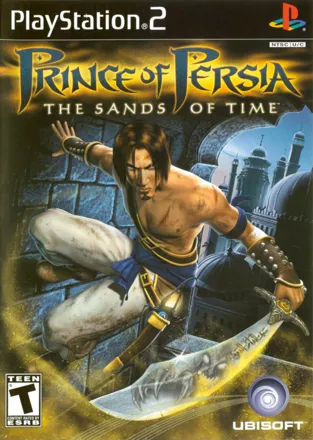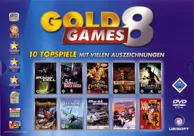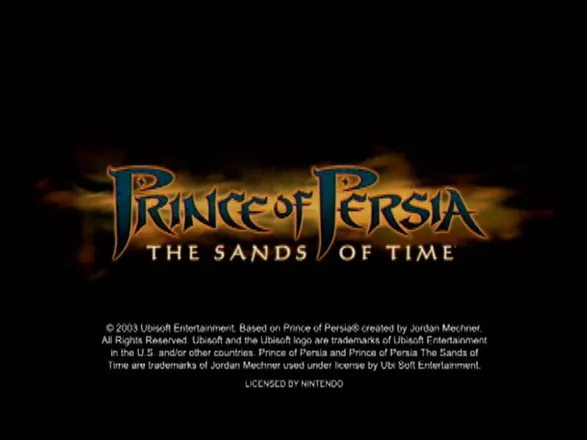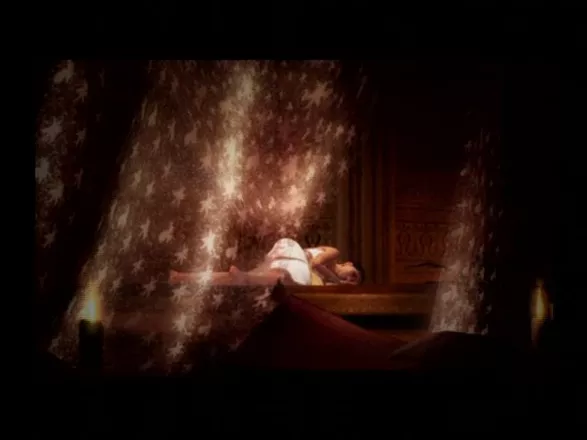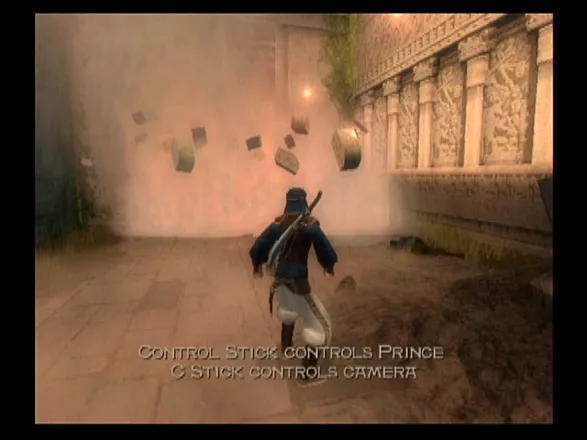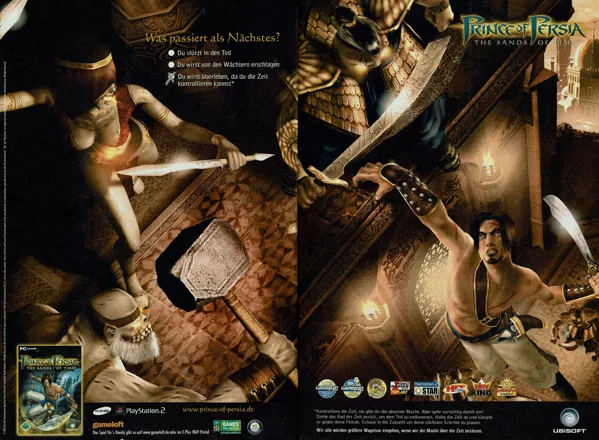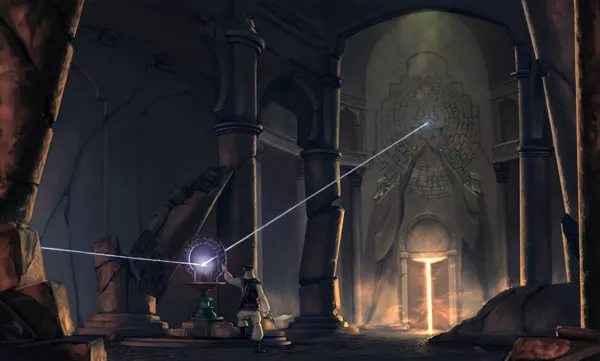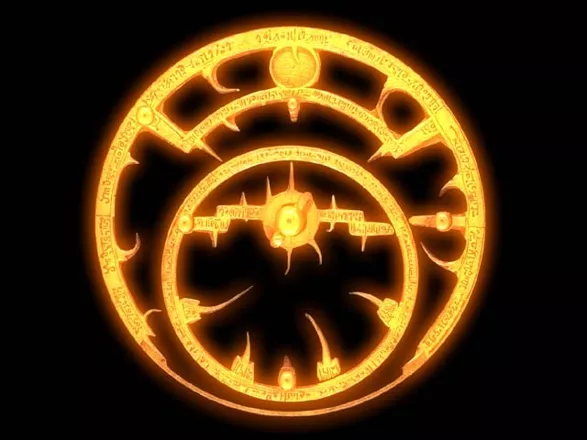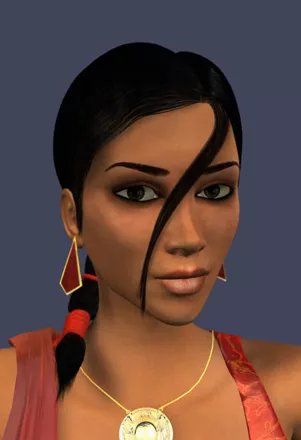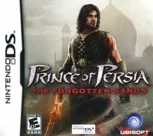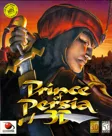Prince of Persia: The Sands of Time
-
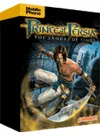 Prince of Persia: The Sands of Time
(2003 on
BREW,
J2ME,
Symbian)
Prince of Persia: The Sands of Time
(2003 on
BREW,
J2ME,
Symbian)
-
 Prince of Persia: The Sands of Time
(2003 on
Game Boy Advance)
Prince of Persia: The Sands of Time
(2003 on
Game Boy Advance)
Description official descriptions
The King and the Prince of Persia are besieging the Maharajah's castle to plunder the treasures hidden inside. In order to impress his father, the Prince sneaks inside to recover the magical Dagger of Time. He quickly learns that this dagger has the ability to control time. The malevolent Vizier has other plans for the dagger, however, and tricks the Prince into unlocking a mysterious secret of the Dagger that causes the King and many of his subjects to be turned into sand zombies. Now, the Prince must figure out what has happened and try to set things right again.
Prince of Persia: The Sands of Time is an action game with platforming and puzzle-solving elements. It updates many of the gameplay concepts from the previous games, and brings them into a fully three-dimensional world. The Prince will engage in sword fighting, wall climbing, spike dodging, puzzle solving, and more in his quest. The Prince also carries the Dagger of Time, which allows him to unleash several magical powers. The most important of these powers is the ability to reverse time. This ability allows the player to reverse their actions when they lead the Prince to his death.
Spellings
- Принц Персии: Пески Времени - Russian spelling
- 波斯王子:时之砂 - Simplified Chinese spelling
- 波斯王子:遺忘之砂 - Traditional Chinese spelling
Groups +
- Covermount: Fullgames
- Covermount: Level (Romania)
- Game Engine: JADE
- Gameplay feature: Time manipulation
- Games made into movies
- Games with hidden / unlockable full games
- Green Pepper releases
- Middleware: Bink Video
- PlayStation 2 Greatest Hits releases
- PlayStation 2 Platinum Range releases
- Prince of Persia series
- Protagonist: Royalty
- Setting: Indian
- Software Pyramide releases
- Theme: Time travel
- Ubisoft eXclusive releases
- Xbox Platinum Hits releases
Screenshots
Promos
Videos
Add Trailer or Gameplay Video +1 point
See any errors or missing info for this game?
You can submit a correction, contribute trivia, add to a game group, add a related site or alternate title.
Credits (PlayStation 2 version)
250 People (223 developers, 27 thanks) · View all
| Producer | |
| Creative Director | |
| Lead Programmer |
|
| Lead Level Designer |
|
| Art Director | |
| Animation Art Director | |
| Art Production Manager | |
| Animation Production Manager | |
| Sound Designer | |
| Writer | |
| Game Designer | |
| Creative Consultant | |
| Associate Producer | |
| Level Design Team | |
| Programing Team |
|
| [ full credits ] | |
Reviews
Critics
Average score: 91% (based on 115 ratings)
Players
Average score: 3.9 out of 5 (based on 246 ratings with 10 reviews)
I feel as if I've live this moment before....
The Good
This was one of the first PS2 games I remember buying other than ICO.
I'll jump right on the graphics as usual. AMAZING! I new the PS2 was capable of these sort of graphics, but it's so much better when you actually get to see them in motion. I love the way the prince moves effortlessly across walls, it's so smooth and natural looking that no other games acrobatics can match it. The environments were dreamlike and absolutely surreal at times. The glowing ,sparkly fog in some of those levels could only work in this game. The character models could have been better as far as the hands were concerned, but that is such a small gripe compared to how wonderful they look. The monsters are all very imaginative and very challenging. Fara and the prince look exquisite and are some of the best I've ever seen on the PS2.
Now on to the sound. Half and half. Sometimes it's at the right volume, and sometimes it's far too low. I know some of it was for dramatic effect, but it can be to quiet for it's own good. The voice acting sometimes sounded rush but rarely stilted or stiff. But overall it was very well done and incredibly convincing. I also like the music, even if doesn't fit the age it's in.
The con-trolls were very intuitive and easy to learn after a few tries. There isn't much other than that to discuss in the con-troll department.
Now on to the gameplay. THIS IS ONE OF THE MOST ROCK SOLID GAMES I HAVE EVER PLAYED!!!!
Seriously! Jumping from walls, running on walls, jumping off platforms precariously perched over bottomless pits, swinging from poles, and the revolutionary realtime rewind all come together for a amazing experience ! And something else I didn't experience in any other game before was how the story was told with minimal cutscenes. You'll be pulling a lever and the prince will start his tale from that particular point. The distance between save points was annoying, but not aggravating. Overall no major complaints here! Oh, and the load times are always short! No long waits! And one last note, the original Prince of Persia is a unlockable ! I never got past level two, but it's the original! Come on !
The Bad
Some of the sequences where you have to jump between walls was kind of hard. And some of the fights early on in the game could drain your patience if you didn't have a lot of it. And in the original game that you can unlock, I can't make that last jump in level two.
The Bottom Line
Get it ! you'll love it ! The best Prince of Persia game since the original is the best one since! No other sequel will ever match what this one did.
PlayStation 2 · by GAMEBOY COLOR! (1990) · 2007
Behold the dawning of a new standard in action/platforming.
The Good
“Most people think of time as a river, flowing swift and sure in one direction. But I have seen the face of time, and I can tell you they are wrong: Time is an ocean in a storm. Sit down, and I will tell you a tale like none you have ever heard.”
The persian king Shahraman and his army return home after a great victory over the indian maharajah, with bags full of treasures and new women for the king's harem. In the way they stop to visit the rajah's palace. As a sign of friendship, king Shahraman gives the rajah an enormous and beautiful hourglass. The rajah approaches it with wondering eyes. “Why are the sands glowing?”, he asks.
The former maharajah's vizier, now at king Shahraman's service, steps forward and explains: “These are the Sands Of Time. Inside this hourglass there lies a marvel like none ever seen by any man. But alas, only the Dagger of Time can unlock the hourglass...”
The vizier stares at king Shahraman's son. The Dagger is the treasure the young prince claimed as his own.
Farah, daughter of the maharajah and now a prisoner of the persian king, makes an attempt at a warning: “Don't do it!” --but it's too late. The prince of Persia already sank the dagger in a key-lock mechanism on the hourglass.
As the hourglass opens, something is released with the sands. Whatever it is has certainly never been seen by any man... but it isn't any kind of marvel either.
Prince of Persia - The Sands of Time (from now on we'll just call it PoP, shall we? there's a 20KB limitation for reviews at this website... which I'm now closer to clash with, thanks to this pointless observation) takes the flag of an old side-scrolling platformer created by a wiz called Jordan Mechner, which made history with its incredibly realistic character animation, imaginative platform puzzles, and complex sword-based battle system. In 1989
Now, in this era of floating-point calculated 3D environments, massive poly-count motion-captured character models, and multiple programmable per-pixel shading effects, Ubisoft Montreal comes up with another heir to the legend, trying to set new standards.
THE VISUALS: The mandatory DX9 bells & whistles
Talking about good looking graphics is almost a waste of time nowadays. Even in those rare cases in which the character models don't sport mind-bendingly huge amounts of polygons, the programmable pixel and vertex shaders allow a fairly easy implementation of a sheer amount of special effects.
PoP is a good example of the above sentence. The models actually have a VERY low amount of polygons (more on this in a minute); but the textures, the shadows, the lighting, the special effects, the design of the environments, the details in the decorations --they are all impressive enough as to divert your attention and even make you think: “Wow, this game looks amazing!”, not noticing that the maharajah's daughter doesn't even have fingers in her hands.
There's an option to apply a lighting effect called "bloom", which gives graphics some sort of misty quality and works as a surprisingly effective inhibitor for the infamous jaggies, and at the same time adds nicely to the general Arabian Nights' Tales theme.
Furthermore, there's the treat of watching it all in motion. It's simply amazing. The camera makes all these crazy zooms and pans and whatnot, transforming each jumping puzzle in a small action movie. In this regard, the cutscenes show a brilliant direction and sport all those effects we are so used to see in modern action movies: Odd camera takes, slow-motion movement, physics-defying acrobatics, et cetera. There are a few pre-rendered cutscenes (at the beginning and near the ending), but the ones with in-game graphics have little to envy from them anyway.
SOUND & MUSIC: Iran Rocks!
I don't usually pay much attention to music in games, since only in a few, rare occasions I found a soundtrack I considered worth of mention. Well, PoP is one of those rare examples.
As I said many times before, I suck at describing music, so I'll go through the heresy of calling these "some sort of mixture between typical arabian music and rock n' roll guitars".
That might very well not tell you anything, but just stay on me: The music is great, it matches the action perfectly, and it's so good you might consider hunting down the soundtrack. After you beat the game the credits roll with a beautiful vocal song that alone makes the whole experience worth it.
Finally, I played the spanish version of PoP, which is fully dubbed. Whoever played the spanish version of any game knows how awful the dubbing actors usually are, and if you can compare, it's heart-grindingly painful to hear how badly they butcher the original acting --well for the first time ever I don't have a single complaint about the voices.
I ignore who did the spanish dubbing in this game, but they did a solid work.
GAMEPLAY: Define "smooth"
Simply put, PoP offers the smoothest gameplay system ever --EVER.
Oddly enough, you get to perform a lot of combat movements with one single attack button, depending on contextual circumstances such as the direction you move while attacking, or the position of the enemies around you: Slash one enemy in front of you, and move the stick back pressing attack again, and our good prince will perform an elegant counter strike manoeuvre against whoever was lurking behind him. Move towards an enemy and press jump, and the prince will vault over him and land right behind, blades shining, ready to give some soup. Run towards a wall and press jump twice, and the prince will rebound-jump off the wall, vaulting over the nearest enemy. Press the attack button repeatedly while pointing towards each enemy around you and, as long as there are targets at hand, the prince will engage in a deadly and elegant ballet of hack & slash combos, taking down everything in his path. Block an enemy blow in the exact moment the blades clash and press the attack button, and the prince will kick the enemy and take him down with his sword.
At times, you get to pull so many different moves in a single fight that you might wonder whether you're actually playing or just pointlessly shaking the sticks and hitting buttons to an awesome cutscene.
For the better part of the game you'll enjoy the company of Farah, the maharajah's daughter. She will help you solving some puzzles, and as she has a bow and arrows she'll also help in the fights. Farah happens to be a fairly good fighter, so this is one of those extremely rare games in which your sidekick not only is far from a burden, but she's actually useful! Oh the shock!
All the fantastic combat moves I just talked about are nothing when it comes to the prince's abilities to face the platform puzzles.
This agile lad can walk, run, jump, hang from ledges, climb up / slide down ladders and columns, walk across tightropes, swing on ropes, swing on flagpoles, shimmy across ledges, rebound-jump off walls, and my favourite: Run up and along walls.
Yep, our man in Persia can actually walk on walls. Neo was a fag.
As you might have guessed, all these movements can be combined in order to come up with some outstanding acrobatic combos, and in fact you will be required to do so, as the game focuses heavily in progressively harder platform puzzles.
For example, let's say you come doing the merry shimmy across a ledge, until you a see another ledge above you. Jump, grab, pull yourself up. Solid ground, phew. But then walk a few steps and, crap, a large chasm, across which you can see a flagpole. So you take a deep breath, start running along the wall (while running you come across a few hanging banners, which will nicely wave as you run by them), and once you're in the right spot you rebound-jump off the wall and grab the flagpole. Swing on it, and jump off towards the nearby wall, off of which you'll rebound-jump and grab a ledge above the flagpole. Turns out this ledge is right at the bottom of a narrow chimney-like vertical space, so you'll jump forward, rebound-jump off the wall, and you'll start a rebound-jumping-spree between enclosed walls until you climbed high enough as to grab another ledge. Pull yourself up. Phew, solid ground again...
The design of these platform puzzles is simply brilliant, basically requiring you to solve them in two stages: First figuring out the course you'll have to take, and second actually running through that course.
As you progress in the game, the platform puzzles will grow larger and more complex, requiring you to combine more and more acrobatics in order to beat them, and eventually featuring timed sections so properly timing your movements becomes a factor as well... rest assured you won't get bored easily.
But there is more! Throughout the game there are a number of "regular" puzzles, the kind of massive room-sized puzzles we found in
For example, at one point in the game you need to re-arrange a number of mirrors in a large two-stories library in order to get a thin stream of sunlight to trigger a certain photosensitive device. Fairly easy to figure out, it does require some thinking in the actual solving, as I think every puzzle should be.
Of course, maybe you're like me, and you still want more --well THERE IS MORE!
From the moment you get the Dagger of Time, you'll be granted access to its several time-bending powers, among which count the ability to freeze enemies, slow down time (yep, much like
You can't possibly imagine how handy this last feature comes when you screw up the last jump of a long platform puzzle.
Finally, one thing that made me remember the recent
PoP, on the other hand, simply sports the best camera ever seen. Not only it makes some nice-looking cinematic shots by itself every now and then, but you can also control it at every moment.
And I do mean CONTROL IT.
You can zoom out to the point the whole scene looks like a 3D version of
Reading all this, you might think: “Jeeesus Christ in a motorbike! How complicated can be to perform all those things!?!”.
Well, it is not.
Controlling the prince and getting him to chain up the craziest combo of acrobatics while at the same time fighting four enemies could only be any easier if you could just project your mind onto the prince and command him through pure thought.
Barring that, playing with mouse and keyboard is as smooth as it gets. No control interface designed by a human being so far has been more user-friendly than this. Period.
Furthermore, if you're the lucky owner of a dual-stick gamepad, rejoice: You're in a gamer's paradise.
THE STORY: A cheese-free love story
When I started playing the game I thought of the story as a predictable and unsurprising "The Prince vs The Evil vizier" cliched tale. Since the gameplay was so enjoyable I didn't really care to think much more about it.
Then Farah showed up and we formed this team, and as the game progressed, these guys started this childlike push & pull, constantly going forth and back between fighting and flirting. Whenever I was left alone with the prince, his voiceovers made clear the way his feelings towards the girl were growing deeper by the minute. Granted, the outcome of this relationship could be guessed from the get-go, but the tale was told with so much class, a few humorous moments, and a surprising lack of cheap cheesiness, that it was totally enjoyable.
In fact, this "troublesome love story" sub-plot was much more enjoyable than the "main" story arc itself... until all of a sudden, in the last five minutes of gameplay, I came to understand the full joke. The whole "chase the vizier and lock the infamous hourglass" was in fact the sub-plot, merely a vehicle for the love story.
At the end of the game it all ties up and connects with the very beginning, closing a perfect circle with a major twist which, however predictable, oozes style as few things I've ever seen.
The ending itself, meaning the very closing phrase uttered by the prince -not without a delightful touch of bitterness, by the way- is brilliant in its own simplicity. In fact, this has to be one of the most rewarding endings I ever came to enjoy.
And then there comes the beautiful vocal song I mentioned above to which the credits roll, and you can't possibly deny that the whole package spells perfection.
The Bad
This game has to be the first in a good while in which I can't find a thing to complain about. Everything I usually care about in a game is nicely covered here: Everything I just described performs quite nicely in my awfully low-end box, and I haven't found one single bug or glitch of any kind. Not even the ever-present clipping issues.
The one thing I could whine about has to be the poly-count, especially when it comes to character models. The prince is fairly good, but the other characters have a noticeable low amount of polygons.
This can be understandable in the enemies, given the huge size of the environments, the massive amount of actors showing on scene at once, and the brief life they're going to have anyway; but Farah's model suffers from the same problem, and it tells. Especially since she doesn't even have fingers in her hands, and you will see those disturbingly hideous hands in some close-ups during certain cutscenes.
The Bottom Line
I'm not into medieval mid-eastern settings at all. In fact, I neglected this game for as long as I knew of its existence, despite the multiple praises I kept hearing all over the place. However, the moment I got a chance to test-drive it, I could only think of one thing: I HAVE GOT to own this game.
Without actually inventing anything new, PoP simply puts together the most challenging and imaginative platform puzzles and the smoothest combat interface I can remember.
On top of this, a simple yet beautiful love story told with a stylish narrative, and a conclusion to remember for years to come.
After I finished this game, and as the credits started rolling to the beautiful song, I felt a fulfilling sense of satisfaction as I felt few times before. Only a few of MAJOR storytelling masterpieces such as
PoP undoubtedly deserves a honor seat among my favourite games ever.
Finally, as some have said, the game IS short. However, I don't think of this fact as PoP's fault; but as a downside of every other game out there, for not offering half of what this one does.
Windows · by Slug Camargo (583) · 2009
The Good
As if we needed more proof that nostalgia sells more games than originality, here we have another next-generation revival of a classic game series: Prince of Persia, which everyone must remember from it's glory days of 2D platforming. However for the poor Prince, this isn't his first "resurrection" as he was brought to the brand new world of 3D adventure once before in a title that only brought embarrassment to anyone that came into contact with it. It is thanks to that title that my expectations for "Sands of Time" were pretty low, however Ubisoft proved with this title that they really have a midas touch lately, and thus they developed a game that is nothing short of genius.
Not concerned with following the original game's chronology, the game casts you as yet another "Prince of Persia" who (along with his father) gets tricked into invading a kingdom by an evil Vizier (who else?) in order for him to get his hands into the magical "Sands of Time" held there. The problem for the Vizier comes when our glory-seeking Prince goes beyond the call of duty and takes a dagger that holds the key to the sands as a trophy in the invasion. After a failed attempt by the Vizier to get the dagger, the Prince unleashes the sands by mistake and turns everyone in his castle to some kind of sand-zombies with only himself, the Vizier and a mysterious girl remaining alive. It's up to the Prince and his newly found ally to now make their way through the castle and face the Vizier with the hope to turn everything back to normal.
As expected, the gameplay follows most of the 3D action-adventure rules, you have to jump and run around, crawl through ledges and slash at whatever comes your way. But Ubisoft added an innovative batch of gimmicks and refined the "classic" bits of the genre so as to make it an almost perfect game. The main flow of the game follows the classic design of the series, which has you sorting all sorts of traps and pitfalls through acrobatic stunts. These include jumping around, rolling, mantling, climbing ladders, bouncing off-walls, pole-swinging and in a cool Matrix-inspired addition, even running on walls! Combat uses a simple scheme of two-attack buttons plus a block one, which is easily one of the best combat systems ever implemented (so good in fact, that it became the focus of the sequel: Warrior Within) opponents are auto-locked as expected nowadays (meaning your movement automatically switches to circle-strafing around the closest enemy). As it often happens in these games however, you are easily surrounded by several opponents and anyone who's ever had a fight in these games is surely familiar with the uncomfortable feeling of having to maneuver what's essentially a giant cardboard box that can only strike in one direction and has to line up to every enemy accordingly... Well, not anymore thanks to Sands of Time! Since the game incorporates the ability to direct your attacks by just pressing the direction your desired opponent is in while you strike. This doesn't mean that your Prince jerks back and forth facing each direction you direct him to, but instead means that he actually twists his torso, kneels and leans towards each direction in a completely dynamic manner. If that alone sounds incredible just wait until you see the way the game works around it, as the added fluidity and adaptability of the combat scheme means your opponents can strike you faster and come in bigger numbers. The results are incredibly dynamic battles that for the first time make fighting in these kind of games a true joy, and that's without taking into account the pre-made yet varied and extremely well done animations that makes each blow and parry a different experience or the acrobatic stunts that allow you to vault over your opponents and bounce between them and strike from above, etc. Most impressive of all however, is how the folks at Ubisoft managed to keep it from getting a completely confusing frenzy by carefully judging the timing in the movements, animations and opponents. One can't help but feel that each fight has a distinct... I dunno... "tempo" as if it were music of some kind, with a rhythm of it's own. Just look at the way the prince holds it's stance after performing a strike as if waiting for the right cue for his next action, blocking and countering are even more obvious as you can distinctively feel the constant pauses between each movement. I don't know, maybe I've had too much of the funny smokes, but no other fighting scheme has ever made feel such things, (except for Virtua Fighter, of course).
Anyway, for as amazing as those gimmicks seem, they pale in comparison with the gimmick that initially sold the game, and which is the time-altering powers of the sands of time the Prince wields. Held in your dagger as a collection of sand tanks, you can use them in a variety of ways such as freezing your opponents in time, make you move at blinding speeds (by putting everything but yourself into slow-motion) and of course, reversing time. That's right, the game actually keeps a constant buffer of some kind of up to 10 seconds of playtime which you can always rewind back to should something go wrong. I cannot even begin to describe how much this revolutionizes the classic platformer gameplay, as it effectively kills the frustration of having to re-do entire game areas because you failed in a specific jump or trap or whatever, as you can cheat death by rewinding back to the point where you screwed up and try it again! Don't worry tough, as this feature is carefully managed and doesn't kill every surprise in the game as one might initially think. The level design alone makes sure the game always holds a nice surprise for you, and it's carefully designed layout makes them super-tight experiences which fail to fall to the classic pitfalls of the genre. This I believe, is thanks to the distinctive 2D logic behind them, which one can easily see whenever one activates the "landscape" view in the game which zooms the camera out to show the player the layout of the particular location he's in. This doesn't mean that the game is merely a 2D platformer done in a polygonal engine, but that the game follows the tight spacing rules and design basics that games like the original Prince of Persia pioneered, a concept more games of this ilk should keep in mind whenever they get lost in the pitfalls of their 3D gameworlds. The careful design means that even the few "puzzle-rooms" found in the game are intuitive and straight-forward, and the addition of "visions" that are just hints perfectly integrated into the context of the game help the player deal with the more challenging situations (and introduce story points every now and then).
Finally, the game is polished and pampered beyond belief thanks to Ubisoft's tremendous production values (which alone crowns them as the European equivalent of EA). The graphic design of the game is simply amazing, with a graphic engine that fully exploits the vertex and pixel shading capabilities of today's GPUs. The engine really falls under the Doom 3 category of "shading engines" which exploit lightning tricks, shading effects and assorted stuff instead of concerning itself with pushing more polygons, in fact the models in Sands of Time aren't impressive at all, but due to the impressive bloom and lighting effects you really couldn't care less about it. Noting down all the kickass effects in the game is really pointless as the game is filled with the now popular distortion effects and motion blurring, but for as good as those are one can't help but feel that it's the small details that really steal the show. Just as an example consider that the game includes caustic reflections for the water! Well, it's obviously a texturing trick as an engine that could make real-time caustics would require a SGI machine at the very least, but it's so well made you'll hardly notice it! Also, a hazy blooming effect is applied to the entire screen, giving it a dream-like soft-focus quality (think of movies like Excalibur) that not only fits the game like a glove by helping the game get that "1001 Nights" motif, but also comes in handy as an additional anti-aliaser as another reviewer mentioned. I can go on and on but you can understand the concept by just taking a look at any screenshot and seeing how this game looks like nothing else. What you can't understand by looking at a screenshot is the incredible character animation, which blends motion captured stuff with character studio-like animation to deliver amazingly lifelike animations (a must for the game really, as the original POP is so fondly remembered among other things, by it's character animation). As an animator myself, I often cringe at the animations in most videogames because they often forget about the anticipation, release and reaction that follows each movement, and which more often than not are the things that sells the idea of a credible, organic movement. This concept is not ignored in Sands of Time and the results are some of the most amazing character animations seen in recent days, and makes each of the many acrobatics and movements made in the game a true pleasure to watch. The camera work also deserves praise as one of the best ever made, not only does it find a way to always position itself in non-intrusive positions, but also goes into slow-motion and switches to "dramatic" positions with a remarkable sense of style that the competition to shame (see? This is how you do slow-mo Max Payne!).
To further complement the game, the sound department received the same care and attention than the graphics, with spot-on sfx, stellar voice acting that permeates every aspect of the game (with the Prince recounting his experiences and adding comments whenever you die, for instance, as if he was telling a tale [which is actually what he is doing] and made a mistake or lost his train of thought ["Wait... No, That's not how it happened" :D]). But most impressive of all, the game has a uniquely and extremely well-designed dynamic soundtrack that mingles Arabic and oriental orchestrations using cittaras and similar instruments with well placed guitar riffs and bass lines that move the entire soundscape from moody oriental tunes to a bitching heavy Arabian-rock mix whenever the action heats up. Oh, and lest I forget, the pre-rendered cutscenes that move the story along are simply amazing in it's quality, not to mention very entertaining, including a particular one that has to be among the most erotic cutscenes I've seen in a videogame (meaning erotic in the good sense of the word, tapping into atmosphere and seduction instead of just plain sleaze as most games [including Warrior Within] often do).
This (the cutscenes, not the eroticism!) brings me to the story of the game which is another jewel in this game's crown, telling a wonderfully entertaining story of love and adventure that not only keeps the player hooked to the end (and what an end that is!) but also charms the player with well-defined characters that follow a classic adventure story but which manage to never feel forced or fall "out of character" while they pursue their quest to undo the damage caused by the Sands of Time. And as I said, the ending alone deserves praise for being one of the most fantastic endings I've played in recent memory, a true beauty of simplicity that nonetheless is incredibly smart and charming as it lets the story and characters come full-circle, and which leaves the player with an incredible sense of gratification and delight after playing it. I can obviously see how this can seem as blind praise, as I can't really tell you why the ending is so great, but trust me, it kicks ass.
The Bad
I'm really hard pressed to find any flaws in this game, but if I had to think about it I would say that it can get pretty easy and short. Particularly easy, as fighting can be a no-brainer at times and the final showdown with the Vizier is a joke.
However there is one thing that totally sucks ass and that is that for the PC version of Sands of Time the developers ditched all the extras found in the console versions (and for those of you that don't know, those include full versions of POP1&2 as well as a reworked version of the first level of POP1 made with the Sands of Time 3D engine). This isn't the first time developers pull this kind of shit on us PC users, and quite frankly I'm getting really annoyed at this.
The Bottom Line
A fantastic game of high adventure that blends stellar and innovative gameplay, a fantastically entertaining storyline and enough production values to put most Star Wars games to shame. Prince of Persia is that rare case where the individual parts of the game are executed with incredible care and talent and the end result, thanks to stellar gaming design manages to be even better than the sum of it's parts. It's meager length and challenge can be somewhat puzzling to some players, but that only means you can play it again sooner!
Now all I need to do is find the idiot that is taking revenge on the PCs superior gaming power by cutting down on our supply of extra features when it comes to porting games.
Windows · by Zovni (10504) · 2005
Discussion
| Subject | By | Date |
|---|---|---|
| Random slowdowns... | chirinea (47496) | Aug 13, 2008 |
| Which control is best for this? | chirinea (47496) | Feb 23, 2008 |
Trivia
1001 Video Games
Prince of Persia: The Sands of Time appears in the book 1001 Video Games You Must Play Before You Die by General Editor Tony Mott.
Advertising
The Internet marketing for Prince of Persia: The Sands of Time was Ubisoft's most successful campaign so far. Ad agency Digital Outlook targeted 15-24-year-old males with ads featuring characters from the game and its "acrobatic action gameplay". A DHTML overlay showing the Prince slicing through the computer screen with his sword had a click-through rate of 26.1%. A streaming video ad, showing the gameplay, had a click-through rate of 23.43%. These rates were 4x higher than the host site's average.
Armitt, Claire. Prince of Persia: the Sands of Time. (Case Study)" New Media Age. May 6, 2004 p30.
Cover
The PlayStation 2 Greatest Hits budget release of the game confusingly uses the cover art of the 2010 game Prince of Persia: The Forgotten Sands.
Farah
Curious about how Farah feels about the Prince? Use the free-look button to look at her during the game to see how their relationship grows.
Murals
On the opening level, just after the room in which you first see the sands of time / giant hourglass, you find a water-filled passage that has 6 murals on the walls. The contents of the murals seem to describe the legendary history of the sands of time :
1) A blue god and winged goddess cradle the earth
2) A red demon kills the blue god as he sleeps
3) The red demon stalks the earth, eating humans
4) The blue god returns from the dead and strikes down the red demon with lightning
5) The blue god collects the sand from the red demon and pours it into an hourglass
6) The blue demon grow four arms - 2 sport the hourglass - 2 carry a sword and the severed head of the red demon. Humans worship at his feet.
Hidden games
The Playstation 2 and Gamecube versions feature a hidden version of the original Prince of Persia , which once unlocked can be played at will.
The X-Box version of the game features the first Prince of Persia, but also features a hidden Prince of Persia 2: The Shadow & The Flame, which will also show up as unlocked content.
The Windows version of the game does not feature either game hidden anywhere.
Rustam
Several times the main characters mention the "legendary" Rustam in comparison to what the Prince is able to do. Rustam was a Persian hero noted for his great strength. Born with prematurely gray hair, Rustam slew a rampaging white elephant with a single blow at the age of ten.
More at "Rustam." Encyclopedia Mythica. 2004. Encyclopedia Mythica Online.
Awards
- 4Players
- 2003 – Best Console Graphics of the Year (PlayStation 2)
- Computer Games Magazine
- March 2004 - #7 Game of the Year 2003
- Computer Gaming World
- March 2004 (Issue #236) – Action Game of the Year
- March 2004 (Issue #236) – Weapon of the Year (for the Dagger of Time)
- EGM
- February 2006 - #166 out of 200 of the "Greatest Games of Their Time"
- GameSpy
- 2003 – #10 Game of the Year (together with SoulCalibur II)
- 2003 – #4 Xbox Game of the Year
- 2003 – #9 GameCube Game of the Year
Information also contributed by Big John WV, PCGamer77, Rupert Breheny, Sciere and WildKard
Analytics
Upgrade to MobyPro to view research rankings!
Related Sites +
-
Prince-of-persia.com
Official website -
The Final Hours of Prince of Persia: The Sands of Time
Gamespot's extensive article about the production process of "Prince of Persia: The Sands of Time". -
Zarf's Mini-Review
A mini-review of the PlayStation 2 version of The Sands of Time by Andrew Plotkin (November, 2003).
Identifiers +
Contribute
Are you familiar with this game? Help document and preserve this entry in video game history! If your contribution is approved, you will earn points and be credited as a contributor.
Contributors to this Entry
Game added by quizzley7.
PlayStation 3 added by Charly2.0. PlayStation 2 added by Corn Popper. Xbox 360, Xbox One added by Plok. Windows added by Cyberzed. Xbox added by JPaterson.
Additional contributors: MAT, Terrence Bosky, Unicorn Lynx, Apogee IV, JRK, Johnny "ThunderPeel2001" Walker, Sciere, Simone Curti, Zeppin, Eltahriel, Patrick Bregger, FatherJack, 一旁冷笑.
Game added November 30, 2003. Last modified March 7, 2024.
